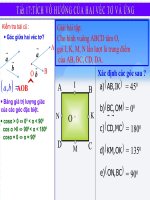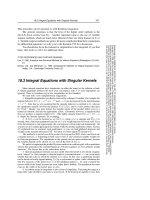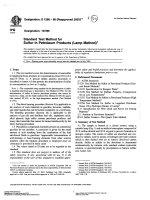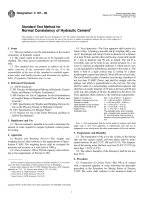Astm c 287 98 (2012)
Bạn đang xem bản rút gọn của tài liệu. Xem và tải ngay bản đầy đủ của tài liệu tại đây (64.16 KB, 2 trang )
Designation: C287 − 98 (Reapproved 2012)
Standard Specification for
Chemical-Resistant Sulfur Mortar1
This standard is issued under the fixed designation C287; the number immediately following the designation indicates the year of
original adoption or, in the case of revision, the year of last revision. A number in parentheses indicates the year of last reapproval. A
superscript epsilon (´) indicates an editorial change since the last revision or reapproval.
lithic Surfacings, and Polymer Concretes
C904 Terminology Relating to Chemical-Resistant Nonmetallic Materials
1. Scope
1.1 This specification covers the requirements for chemicalresistant sulfur mortar, which must be heated and molten to be
used, for bonding chemical-resistant brick or tile. For the use of
these materials, see Practice C386.
3. Terminology
3.1 Definitions—For definitions of terms used in this
specification, see Terminology C904.
1.2 The values stated in inch-pound units are to be regarded
as standard. The values given in parentheses are mathematical
conversions to SI units that are provided for information only
and are not considered standard.
1.3 This standard does not purport to address all of the
safety concerns, if any, associated with its use. It is the
responsibility of the user of this standard to establish appropriate safety and health practices and determine the applicability of regulatory limitations prior to use. See Section 7 for
specific safety hazard.
4. Chemical Composition
4.1 The sulfur mortar shall conform to the following requirements for chemical composition:
Sulfur, %
Inert filler, %
55 to 70
45 to 30
Fillers are usually carbon or silica and can affect the
chemical resistance of sulfur mortars.
5. Chemical Resistance
2. Referenced Documents
5.1 A general guide to chemical resistance of sulfur mortars
may be found in Table 1.
2.1 ASTM Standards:2
C267 Test Methods for Chemical Resistance of Mortars,
Grouts, and Monolithic Surfacings and Polymer Concretes
C307 Test Method for Tensile Strength of ChemicalResistant Mortar, Grouts, and Monolithic Surfacings
C321 Test Method for Bond Strength of Chemical-Resistant
Mortars
C386 Practice for Use of Chemical-Resistant Sulfur Mortar
C413 Test Method for Absorption of Chemical-Resistant
Mortars, Grouts, Monolithic Surfacings, and Polymer
Concretes
C579 Test Methods for Compressive Strength of ChemicalResistant Mortars, Grouts, Monolithic Surfacings, and
Polymer Concretes
C580 Test Method for Flexural Strength and Modulus of
Elasticity of Chemical-Resistant Mortars, Grouts, Mono-
5.2 The resistance of sulfur mortar to specific chemicals
shall be determined by Test Method C267.
6. Physical Properties
6.1 The sulfur mortar shall conform to the following physical requirements:
Tendency of filler to settle, maximum variation from unity
Tensile strength, min, psi (MPa)
Compressive strength, min, psi (MPa)
Flexural strength, min, psi (MPa)
Strength retained after thermal shock test, min, psi (MPa)
Bond strength, min, psi (MPa)
Absorption, max, weight %
0.6
400 (2.8)
4000 (28)
1000 (6.9)
150 (1.0)
150 (1.0)
1.0
7. Test Methods
7.1 Sample the sulfur mortar and determine the properties
enumerated in this specification in accordance with the following test methods:
7.1.1 Sampling and Preparation of Sample—Using a minimum of 5 lb (2.3 kg), melt the sample in less than 1 h. Then
hold at a temperature of 265 to 290°F (129 to 143°C) for at
least 15 min, while stirring with a laboratory-type mixer. This
mixer shall be of such type and operate at a speed to lift the
aggregate, but without beating air into the molten sample. Cast
all test specimens from this sample.
1
This specification is under the jurisdiction of ASTM Committee C03 on
Chemical-Resistant Nonmetallic Materialsand is the direct responsibility of Subcommittee C03.02 on Monolithics, Grouts and Polymer Concretes.
Current edition approved Aug. 1, 2012. Published September 2012. Originally
approved in 1952. Last previous edition approved in 2008 as C287 – 98 (2008)´1.
DOI: 10.1520/C0287-98R12.
2
For referenced ASTM standards, visit the ASTM website, www.astm.org, or
contact ASTM Customer Service at For Annual Book of ASTM
Standards volume information, refer to the standard’s Document Summary page on
the ASTM website.
Copyright © ASTM International, 100 Barr Harbor Drive, PO Box C700, West Conshohocken, PA 19428-2959. United States
1
C287 − 98 (2012)
TABLE 1 General Guide to Chemical Resistance of Sulfur
Mortars
for 30 min. Carefully remove test tube from hot environment
and hold under tap water until mortar is completely solidified.
Break and remove glass from sulfur specimen. A shrinkage
cone will have formed at top of sample on cooling. Cut or
machine off this shrinkage cone portion. Cut remaining mortar
specimen into three sections of approximately equal length.
Grind top and bottom thirds separately using a mortar and
pestle. Perform extraction test on each sample using procedure
outlined in 7.1.3 and calculate filler content of each. Calculate
tendency of filler to settle by dividing filler content of bottom
portion by filler content of top portion.
7.1.5 Tensile Strength— Test Method C307.
7.1.6 Compressive Strength—Test Method C579.
7.1.7 Flexural Strength—Test Method C580.
7.1.8 Thermal Shock Test—Cast at least five tensile briquets
as described in Test Method C307 and store them for 48 h at
ambient temperature. Provide two 5-gal pails, each filled
approximately two-thirds full of water. Maintain the temperature in one pail between 50 and 60°F (10 and 15°C) as the cold
bath, and the other pail between 175 and 185°F (80 and 85°C)
as the hot bath. Place five briquet specimens in a wire cage
constructed so as to hold the briquets spaced at least 1 in. (25.4
mm) from each other. Suspend the specimens in the middle of
the hot bath for 5 min and immediately transfer to the cold bath
for 5 min. After five such cycles, remove the five specimens
and determine their tensile strength immediately in accordance
with Test Method C307.
7.1.9 Bond Strength— Test Method C321.
7.1.10 Absorption—Test Method C413, except that the temperature in 6.2 shall be held at 190°F (88°C) instead of boiling.
NOTE 1—This table is intended for use as a general guide to the
resistance of sulfur mortars in immersed service at ambient temperature,
and may usually be upgraded for spillage only. Specific recommendations
should be obtained from the manufacturer of the sulfur mortar.
Chemical
ResistanceA
Substance
Acids, mineralB (nonoxidizing)
Acids, mineral (oxidizing)
Acids, organic
Alkalies, inorganic
Bleaches
Wet gases, oxidizing
Wet gases, reducing
Gases, nonoxidizing and nonreducing
Organic solvents
R
RC
L
N
N
R
R
RD
L
A
R = generally recommended.
L = limited use.
N = not recommended.
B
Silica filler must be avoided for hydrofluoric acid service.
C
N for chromic acid, sulfuric acid above 85 % and nitric acid above 40 %.
D
N for ammonia gas.
7.1.2 Storage of Test Specimens—Store all test specimens at
a temperature of 73 6 4°F (236 2°C).
7.1.3 Filler Content:
7.1.3.1 Determine the filler content of the sulfur mortar by
extraction with carbon disulfide, (CS2—see warning below)
using Soxhlet-type equipment. Dry and weigh the filter
thimble. Place 10 to 15 g of the sample in the thimble and place
thimble in the extraction equipment. Pour 40 to 50 mL of
carbon disulfide into the flask. Cautiously heat the flask in a
water bath just enough to slowly reflux the carbon disulfide
while circulating cold water through the condenser. Continue
the extraction until the carbon disulfide is clear in the siphon
tube.(Warning—Carbon disulfide is highly toxic and highly
flammable with a flash point of -22°F (-30°C).)
7.1.3.2 Remove the filter. Dry carefully, first at a low
temperature to prevent ignition of the carbon disulfide and then
at 212°F (100°C), to constant weight. Final weight divided by
original weight times 100 equals percent filler content.
7.1.4 Tendency of Filler to Settle —Fill a 1-in. (25-mm)
diameter heat-resistant glass test tube to a depth of 8 in. (200
mm) with molten sulfur mortar and maintain at 285°F (141°C)
8. Packaging and Package Marking
8.1 The sulfur mortar shall be packaged in suitable containers and marked to denote the type filler. Complete instructions
for melting and pouring shall be included.
8.2 Packages may be marked at the discretion of the
supplier and on his responsibility, indicating that the product
satisfies this specification.
9. Keywords
9.1 brick; chemical resistant; hot melt; sulfur mortar; tile
grout
ASTM International takes no position respecting the validity of any patent rights asserted in connection with any item mentioned
in this standard. Users of this standard are expressly advised that determination of the validity of any such patent rights, and the risk
of infringement of such rights, are entirely their own responsibility.
This standard is subject to revision at any time by the responsible technical committee and must be reviewed every five years and
if not revised, either reapproved or withdrawn. Your comments are invited either for revision of this standard or for additional standards
and should be addressed to ASTM International Headquarters. Your comments will receive careful consideration at a meeting of the
responsible technical committee, which you may attend. If you feel that your comments have not received a fair hearing you should
make your views known to the ASTM Committee on Standards, at the address shown below.
This standard is copyrighted by ASTM International, 100 Barr Harbor Drive, PO Box C700, West Conshohocken, PA 19428-2959,
United States. Individual reprints (single or multiple copies) of this standard may be obtained by contacting ASTM at the above
address or at 610-832-9585 (phone), 610-832-9555 (fax), or (e-mail); or through the ASTM website
(www.astm.org). Permission rights to photocopy the standard may also be secured from the ASTM website (www.astm.org/
COPYRIGHT/).
2









